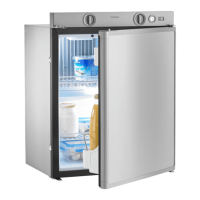13
Refrigerator operation
4.3.1 Electrical operation
Switch on the appliance by turning the energy
selection switch (1) clockwise to position :
12V operation.
230V operation,
The refrigerator should only be used in
12VDC-operation while the vehicle’s engi-
ne is running, otherwise the on-board-bat-
tery would be discharged within a few
hours!
CAUTION !
Fig. 8
Fig. 9
230 V
12 V
1 1
Appliances with battery igniter
4.3.2 Gas operation (liquid gas)
The refrigerator must be operated using
liquid gas (propane, butane) (no natural
gas or town gas). When using LPG gas,
please consider that the burner needs
cleaning at shorter intervals due to the gas
combustion method (2 - 3 times per year
recommended.
In Europe, gas operation is permitted while
travelling only on the condition that the gas
system of the vehicle is equipped with a
hose rupture protection. The national regu-
lations of the respective country must be
observed.
For physical reasons, gas ignition faults
could occur starting from an altitude above
sea level of approx. 3280 ft. / 1000 m (No
malfunction!)
On the initial refrigerator start-up or after a
cylinder change, air may be trapped in the
gas line. To purge the air from the lines,
switch on the refrigerator and any other gas
appliances (e.g. stove) for a short time. The
gas ignites without delay.
Prior to starting the refrigerator in gas
mode :
Open the gas cylinder valve.
Open the shut-off valve for gas supply to
the refrigerator.
As a basic rule, gas operation is prohibi-
ted in petrol stations
WARNING!
1. Turn the rotary selector switch (1) to
position .
2. Turn the temperature selector (2) clockwise
and push. Keep the controller button
depressed.
3. Then, press knob (3)of battery igniter
down and keep it depressed. The ignition
process is activated automatically.
4. Once the flame ignites, the pointer of galva-
nometer (4)(p. 13) begins moving into the
green range. The refrigerator is operational.
Keep knob (2) depressed for approx. 15
seconds and finally release it.
Fig. 11Fig. 10
Fig. 12
1
2
3

